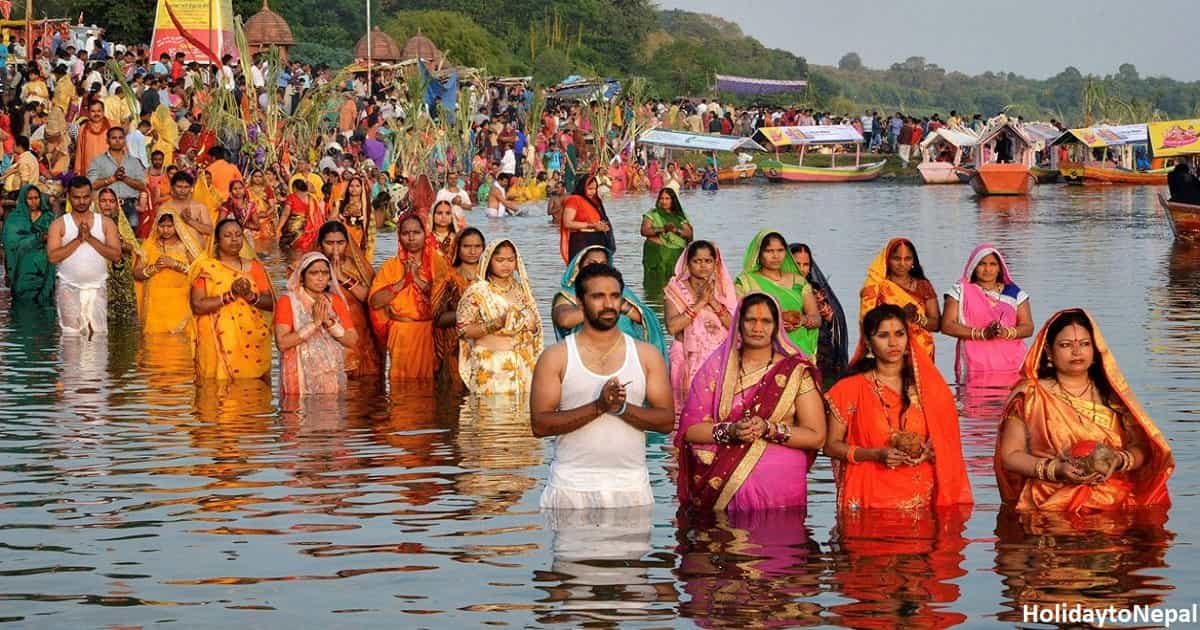
During the Chhath festival, Bratalu is giving argha to the setting sun. There is a tradition of worshiping the setting sun in Chhath festival. The sun is also called 'Adi' deity. It is the sun that gives light to human beings, generates heat in the body and protects from diseases. Therefore, the sun has been worshiped as the intended deity since Vedic times.
As the main essence of Vedic literature is sun worship, it is customary to pray for the setting sun in Chhath festival. The cultists are of the opinion that the characteristic of beginning and end is thus symbolically presented.
The word Chhath has a history of evolving from the Sanskrit word 'Shashthi'. In the four-day Chhath Brat, the day of Kattik Shukla Shasthi is the day of hardship, difficulty, rush, labor and importance. Chhath is a very popular festival celebrated in Nepal and India on the day of Kattik Shukla Shasthi. This festival has come as a corruption of Shashthi Puja. In this festival the sun is worshiped and the sixth mother (Srisapata) is worshiped. This fast, which begins with the offering of argha to the setting sun, is followed by the offering of argha to the rising sun of the next day. The festival, which is very holy, clean and faithfully celebrated, is conceivable from many points of view.
The specialty of Chhath is becoming wider day by day. Formerly limited to the Terai-Madhesh region of Nepal, this festival has been celebrated in Kathmandu and various hilly districts for some years now.
There are many features of Chhath festival which is celebrated every year on the date of Kattik Shukla Shashthi. During the Chhath festival, farmers donate the produce of their own fields. Sunlight is a boon for farmers. There can be no farming without light. Therefore, it is customary to offer the first crop grown from one's farm to the sun.
Although there are different methods of Chhath worship, in the prevailing system in Madhes, importance is given to the setting sun by giving argha to the rising sun. Worship of both rising and setting sun has made the glory of Chhath special and comprehensive. The rising sun is creative and the setting sun is symbolic.
At sunset, Bratalu, standing in the reservoir, offers a drink to the sun. Chhath festival is not celebrated without water and reservoir. Ponds, lakes, lakes and rivers are required for Chhath Pujan. When the sun's heat has completely dissipated, the Bratalu standing in the reservoir gives a drink and prays to rise again in the morning. The sun is worshiped as a symbol of energy. According to culturologists, energy is gained by worshiping the sun.
According to sources, the Argha offered in the evening in Chhath Puja is not for the sun but for the goddess Chhathi. There are two deities worshiped in Chhath - Surya and Chhathi Devi. After Bratalu completes the puja by giving argha to Chhathi Devi in ââthe evening, the rising sun is worshiped the next day.
There is not much difference in the worship material of Chhath, the time and place of giving argha and the method of worship. Items other than agricultural produce are not often used as worship materials. It is also customary for Vratalu and other devotees to wear new clothes on the evening of Chhath.
After the house yard is covered and cleaned, it is kept in a bamboo cover. Worship materials are decorated in Nanglo. Once the deity is worshiped at home, the nanglo with the worship material is re-decorated. On top of that, a burning lamp is carefully placed. Other members of the family, including Bratalu, in their new attire, carry the worship material and move towards the ghat. It is customary for the person in charge of the house to carry the cover full of offerings.
On the main day of the four-day Chhath Puja, the Bratalu and his family members place all the sacred material on the bank of the reservoir adorned for the Saujh (evening) and offer the Argh to the setting sun. Married daughters who do not have Chhath at home also come to Maiti Ghar (Father's house) at this time.
The Bratalu family invites distant relatives and friends. "It's a fun family get-together. Even a 36-hour waterless brat is completed without knowing it.
Although Chhath is a festival of worship of the sun, it can be said that this festival is the religion of social harmony, human harmony, respect for labor and nature and the religion of purity. In the worship of the sun, the ritual cannot be completed without the blessing of the merciful sixth mother. This is respect for mother power. Chhath is the only ritual in which a daughter is wished. There is a clear hint of this in the song of the Chhathi Mata.
The Chhath festival has acknowledged the importance of agricultural production. Life and nature complement each other. The fact that conservation of natural resources is the key to the prosperity of life is confirmed by the offering of different products than is always used in this festival. The use of Gawadi Paddy (Sathi), Suthani, Ginger, Bodi, Sugarcane, Coconut, Sakhar (Sweet), Lemon, Banana Thamba, Wheat etc. has appreciated the labor of the farmers.
Chhath festival protects all the animals in the world. This festival has forbidden the practice of sacrifice. Chhath is worshiped with great importance of vegetarianism and non-violence and purity. The Brahmins do not eat onion, garlic, fish or meat in this festival. Everyone is cheered on this festival.





